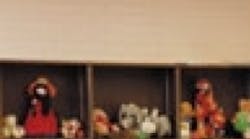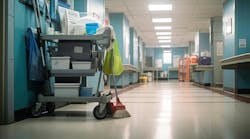Benchmarks for cleanliness can be subjective. For instance, in a residence hall, how many students think that a room with a pile of clothes in a corner on the floor and dust bunnies under the unmade bunk bed is clean, as long as the posters are hung straight?
Now that LEED standards are gaining a foothold among facilities management and building professionals, there is a benchmark to strive for. And a high-quality vacuum is a key part of the equation.
LEED means green
In 1993, the U.S. Green Building Council was created, and the construction industry took a giant step toward developing sustainable building standards. Builders wanted design and construction methods that took into account environmental, health, leadership, awareness and cost-savings issues. The result of their efforts is LEED (Leadership in Energy and Environmental Design), a nationally accepted benchmark and blueprint for building design, construction, renovation and ongoing maintenance.
This coincides with the exponential increase in green cleaning practices. With positive data rolling in from LEED-certified buildings worldwide, indoor environments are becoming more healthful and energy-efficient, and less costly to build and maintain.
A California study on LEED buildings shows observed improvements in worker productivity and morale — plus it's easier to recruit new employees to work in a clean-air building. In hospitals, patients were released 2.5 days earlier; in schools, student test scores improved significantly and absenteeism numbers decreased. The demand for green buildings can be seen in the growing number of sustainable-design architectural firms and green building product suppliers. The data show that these buildings are environmentally responsible, profitable and healthful places to live and work.
Point by point
LEED establishes voluntary performance standards and benchmarks for new construction (LEED-NC), for new school facilities (LEED for Schools) and for existing buildings (LEED-EB), among others. The point system for an environmentally friendly existing building falls into five categories: sustainable site planning, green cleaning and maintenance practices, indoor air quality (IAQ), water and energy efficiency, and system upgrades. Facilities can earn additional points through innovations not listed in LEED, but that still adhere to the overall goals of the program.
Certain base requirements need to be met for the IAQ portion of the program: controlling PCBs, removing sources of tobacco smoke and asbestos, and having a system for outside-air introduction and exhaust mechanisms. Depending on how many subsequent points are earned, a building can be certified as platinum, gold, silver or certified.
When considering IAQ, effective green cleaning practices now are required for achieving any level of LEED certification. Sustainable cleaning products and highly efficient tools must be used properly and consistently to prevent indoor pollutants from affecting the health of the building occupants. Caution: Anyone can call a product “green,” but that doesn't necessarily make it the safest or best to earn LEED points. Other steps to take include isolating janitorial closets from the general public, using low-impact pest-management practices, conducting cleaning audits, and reducing or ultimately eliminating identifiable sources of indoor air pollutants.
Meeting standards
Vacuuming is one of the most important cleaning tasks for maintaining healthful IAQ, so facilities staff should be armed with the right machines.
The first step is to find a vacuum that has been certified by the Carpet and Rug Institute for vacuum performance. This voluntary program rates vacuum performance on soil removal, dust containment levels (must not release more than 100 micrograms of particles per cubic meter of air, keeping dirt and dust locked tight in the vacuum), and carpet texture retention. Its label should appear on the vacuum and in the product literature.
Not all manufacturers can back up their particulate capture claims with hard data. If a company doesn't state its efficiency in what it captures, avoid buying it. There are vacuums on the market that capture 99.9 percent of pollutants 1 micron or larger — a standard that exceeds most cleaning standards, including CRI's.
Because LEED-EB requires a high level of capture and containment of particulates, education institutions may want to consider a HEPA vacuum. Vacuums certified as “True HEPA” have been specially sealed and independently tested for leakage. These are designed mainly for asbestos cleanup, healthcare and clean-room settings. But a well-engineered HEPA machine is quite capable of excellent pollutant capture.
Look for a model with a strong motor that creates good static lift (around 100 inches) and 150 cubic feet per minute of airflow. If the manufacturer does not state that its HEPA vacuum captures 99.97 percent of particles 0.3 micron or more, then don't buy it.
Capture rates are important, but comfort and efficiency for cleaning staff also are critical. Two studies by the Ohio State University Department of Surgery Division of Orthopedics and the Battelle Memorial Institute determined that the ease of use and ergonomic design of backpack vacuums enabled workers to vacuum more than twice the area in half the time. This increase in productivity took less than half the energy and effort it would to clean the same area with an upright.
High-quality body construction is essential for a LEED vacuum. An upright with a beater bar and fabric bag housing the filter can be ill-equipped for effective dust capture. It tends to churn more dust into the air than better built machines. Look for a sturdy backpack or canister with a lifetime guarantee on molded body part replacement. Durability will save money and improve performance in the long run, especially on repairs, because daily vacuuming is required in high-traffic areas such as hallways, building entrances, classrooms and elevators.
LEED standards and guidelines have enabled schools and universities to create detailed cleaning programs with specific goals in mind — and with the right vacuum, certification can be an attainable goal.
Jansik is a freelance writer focusing on the jan/san industry. He resides in Boise, Idaho.
Sidebar: Extra credit
LEED's Indoor Environmental Quality Green Cleaning Credit 3.7 covering sustainable cleaning equipment outlines specifications and initiatives to receive this credit:
-
Establish a program for the use of janitorial equipment that reduces building contaminants and minimizes environmental impact.
-
Vacuum cleaners should meet the requirements of the Carpet and Rug Institute (CRI) “Green Label” Testing Program and operate with a sound level less than 70dB.
-
Use ergonomic power equipment designed to minimize vibration, noise and user fatigue.
-
Keep a log for each type of housekeeping equipment, and document the purchase date, repair and maintenance activities, and vendor specification sheets.



